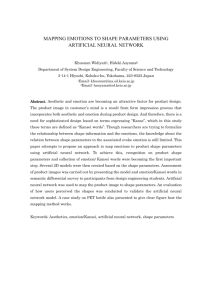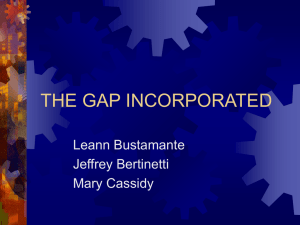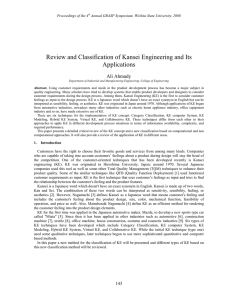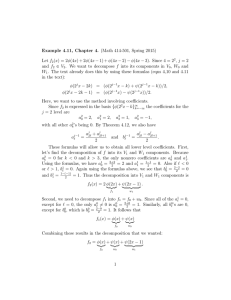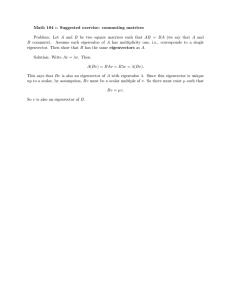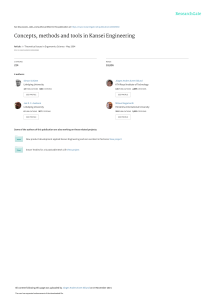The Design Preferences Decision Using the Analytical Hierarchy Process towards
advertisement
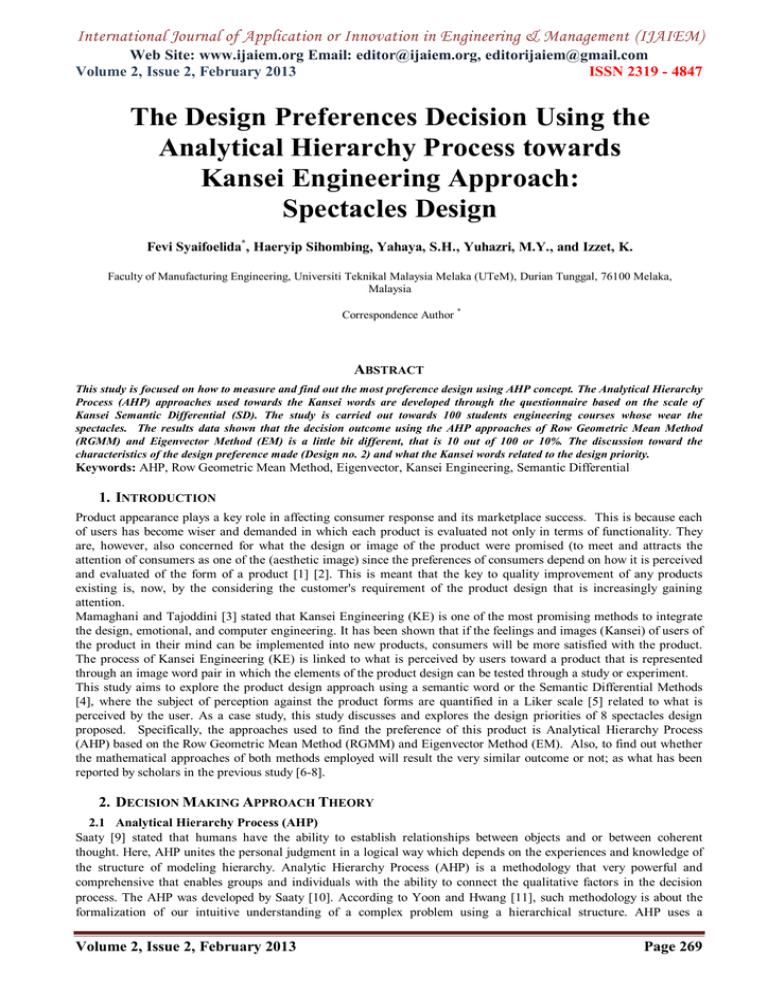
International Journal of Application or Innovation in Engineering & Management (IJAIEM) Web Site: www.ijaiem.org Email: editor@ijaiem.org, editorijaiem@gmail.com Volume 2, Issue 2, February 2013 ISSN 2319 - 4847 The Design Preferences Decision Using the Analytical Hierarchy Process towards Kansei Engineering Approach: Spectacles Design Fevi Syaifoelida*, Haeryip Sihombing, Yahaya, S.H., Yuhazri, M.Y., and Izzet, K. Faculty of Manufacturing Engineering, Universiti Teknikal Malaysia Melaka (UTeM), Durian Tunggal, 76100 Melaka, Malaysia Correspondence Author * ABSTRACT This study is focused on how to measure and find out the most preference design using AHP concept. The Analytical Hierarchy Process (AHP) approaches used towards the Kansei words are developed through the questionnaire based on the scale of Kansei Semantic Differential (SD). The study is carried out towards 100 students engineering courses whose wear the spectacles. The results data shown that the decision outcome using the AHP approaches of Row Geometric Mean Method (RGMM) and Eigenvector Method (EM) is a little bit different, that is 10 out of 100 or 10%. The discussion toward the characteristics of the design preference made (Design no. 2) and what the Kansei words related to the design priority. Keywords: AHP, Row Geometric Mean Method, Eigenvector, Kansei Engineering, Semantic Differential 1. INTRODUCTION Product appearance plays a key role in affecting consumer response and its marketplace success. This is because each of users has become wiser and demanded in which each product is evaluated not only in terms of functionality. They are, however, also concerned for what the design or image of the product were promised (to meet and attracts the attention of consumers as one of the (aesthetic image) since the preferences of consumers depend on how it is perceived and evaluated of the form of a product [1] [2]. This is meant that the key to quality improvement of any products existing is, now, by the considering the customer's requirement of the product design that is increasingly gaining attention. Mamaghani and Tajoddini [3] stated that Kansei Engineering (KE) is one of the most promising methods to integrate the design, emotional, and computer engineering. It has been shown that if the feelings and images (Kansei) of users of the product in their mind can be implemented into new products, consumers will be more satisfied with the product. The process of Kansei Engineering (KE) is linked to what is perceived by users toward a product that is represented through an image word pair in which the elements of the product design can be tested through a study or experiment. This study aims to explore the product design approach using a semantic word or the Semantic Differential Methods [4], where the subject of perception against the product forms are quantified in a Liker scale [5] related to what is perceived by the user. As a case study, this study discusses and explores the design priorities of 8 spectacles design proposed. Specifically, the approaches used to find the preference of this product is Analytical Hierarchy Process (AHP) based on the Row Geometric Mean Method (RGMM) and Eigenvector Method (EM). Also, to find out whether the mathematical approaches of both methods employed will result the very similar outcome or not; as what has been reported by scholars in the previous study [6-8]. 2. DECISION MAKING APPROACH THEORY 2.1 Analytical Hierarchy Process (AHP) Saaty [9] stated that humans have the ability to establish relationships between objects and or between coherent thought. Here, AHP unites the personal judgment in a logical way which depends on the experiences and knowledge of the structure of modeling hierarchy. Analytic Hierarchy Process (AHP) is a methodology that very powerful and comprehensive that enables groups and individuals with the ability to connect the qualitative factors in the decision process. The AHP was developed by Saaty [10]. According to Yoon and Hwang [11], such methodology is about the formalization of our intuitive understanding of a complex problem using a hierarchical structure. AHP uses a Volume 2, Issue 2, February 2013 Page 269 International Journal of Application or Innovation in Engineering & Management (IJAIEM) Web Site: www.ijaiem.org Email: editor@ijaiem.org, editorijaiem@gmail.com Volume 2, Issue 2, February 2013 ISSN 2319 - 4847 hierarchical model consisting of objectives, criteria (and some sub criteria) and alternatives for each issue or decision. AHP is a multi criteria decision-making technique (many criteria) which combines the quantitative and qualitative factors to sort the priorities, status, and evaluation of alternatives. In order to help the decision maker, there are nine point scale of importance between the two decision elements created [12]. Saaty [13] as well as Crawford and Wiliam [14] argued that the approximation method that most widely used in AHP approach and the prioritization method [7] is The Geometric Mean or the Row Geometric Mean Method (RGMM) and Eigenvector Method (EM) where the weight of each element in the matrix through eigenvector method is specifically proposed by Hwang and Yoon [15]. 2.1.1 Row Geometric Mean Method (RGMM) In order to provide sufficient close results in the most situations, Saaty [12] suggested the approach of the geometric mean of a row axis. The geometric consistency index suggested is to measure the individual consistency of judgment matrices. This is one of the most extended of AHP prioritization procedures [7], while Kumar and Ganesh [16] suggested the Approximate Eigenvector (AEV) method. The comparison matrix of the element at row (i) and column (j) is the ratio of row (i) and column (j) is used in both of calculation (RGMM and EM) [11]. The comparison of matrix A shown below (1) and ω1, ω2, until ωn, where the weights obtained (through the comparisons) can be applied in the case. A w1 w1 w2 w1 . . . wn w1 w1 w2 w2 w2 . . . wn w2 . . . . . . . . . . . . . . . . . . w1 wn w2 wn . . . wn wn (1) For an approximation method that provides sufficiently close results in most situations, Saaty [12] suggest that the geometric mean of a row can be computed by multiplying the n elements in each row, then take the nth root, and prepare a new column of the resulting numbers, then normalize the new column (i.e., divide each number by the sum of the numbers). 2.1.2 Eigenvector method (EM) Saaty apply the main of Eigenvector of A as a desirable vectors priority of ω, where the linear system (2) to determine the vector is as stated below [7]: , e 1 (2) Where λ is the principal of Eigenvalue towards A. If the decision maker is constant, the value of λ should be equal to the n. We can also say that the value of λ is greater to the value of n (λ > n). The good estimation on Eigenvalues for the main vector inconsistent matrix is by normalizing the number lines of each element. Various researchers have proved that for small deviations around consistent ratio ωi /ωj of the EM method gives a fairly good approximation of the priority vector. 3. METHODOLOGY The study carried out is towards the students whose wear the spectacles. In this study, the 100 samples taken were from manufacturing engineering students. The assessment instruments used in the study are Kansei Engineering of product design characteristics using a semantic differential approach [4] against 8 of the spectacles designs proposed which each of design consists of 6 pairs of word (Figure 2). Figure 2 Framework of Study Volume 2, Issue 2, February 2013 Page 270 International Journal of Application or Innovation in Engineering & Management (IJAIEM) Web Site: www.ijaiem.org Email: editor@ijaiem.org, editorijaiem@gmail.com Volume 2, Issue 2, February 2013 ISSN 2319 - 4847 Figure 3 shows the varying characteristics of the spectacles frame design ranged from “Full Frame” design to “Rimless” design (1 to 4 as well as 5 to 8). Characteristically, the rim design construction of the frame design no.5 to 8 is solid, compact, wide, and thickness, while the design no 1 to 4 is less solid, more slim, and thinner. At the end of the axis, like no 4 and 8, is the rimless design. Table 1 contains of the Kansei words used with the semantic differential to articulate the design characteristics in terms of emotional or quality affective (F/D, U/A, O/M, L/C, U/I). Figure 3 Variant Designs of Spectacles Table 1: Kansei Words and Design Preferences Fragile Unaattractive Old Fashion Lame Unintuitive Inconvenient fit Durable Attractive Modern Cool Intuitive Ergonomic F/D U/A O/M L/C U/I I/E How much do you like/prefer this frame design? DISLIKE LIKE In order to determine the design preferences, the approach employed is The Row Geometric Mean Method (RGMM) and Eigenvector method (EM) based on the matrix 8 x 8 of the Design Preferences and matrix 6 x 6 of the Kansei words in each design related. 4. RESULT & DISCUSSION 4.1 The Design Frame Preferences by RGMM and EM By using EM and RGMM, from 100 respondents towards the 8 proposed designs versus Kansei words and the Frame Design preferences (Table1), the dominant factor occurred in the design no. 2, which is 43% and 42%. Both approaches are having same dominancy on the design chosen with a little bit different (1%). Table 3 shows the highest of Kansei word based on EM’s approach where the dominant or the preference of design is on the design no. 2 (51%) and the dominant of Kansei word is on “Fragile versus Durable” (F/D). While Table 4 shows the highest preference and the dominant in every Kansei word based on the RGMM approach is also on “Fragile versus Durable” (F/D), that is 41% and the design no.2. Based on this finding, we can conclude that the preference of the spectacles design is on the full frame design with full rim that less solid, more slim, and thinner (Design 2), while the preferences based on Kansei words is on “Fragile versus Durable” (F/D). Volume 2, Issue 2, February 2013 Page 271 International Journal of Application or Innovation in Engineering & Management (IJAIEM) Web Site: www.ijaiem.org Email: editor@ijaiem.org, editorijaiem@gmail.com Volume 2, Issue 2, February 2013 ISSN 2319 - 4847 Table 2: Design Preference OVERALL DESIGN PREFERENCE DESIGN-1 DESIGN-2 DESIGN-3 DESIGN-4 DESIGN-5 DESIGN-6 DESIGN-7 DESIGN-8 EM 24 43 11 17 1 1 1 2 RGMM 23 42 11 17 1 1 1 4 Table 3: Dominant of Kansei Words towards the 8 Design Proposed using EM DESIGNS DESIGN-1 DESIGN-2 DESIGN-3 DESIGN-4 DESIGN-5 DESIGN-6 F/D 5 51 17 18 1 2 U/A 14 42 14 19 1 2 O/M 13 46 16 17 1 3 L/C 15 44 12 19 0 3 U/I 10 46 13 16 3 4 I/E 14 39 17 17 2 3 DESIGN-7 DESIGN-8 2 4 3 5 1 3 3 4 5 3 3 5 Table 4: Dominant of Kansei Words towards the 8 Design Proposed using RGMM DESIGNS F/D U/A O/M L/C U/I I/E DESIGN-1 DESIGN-2 DESIGN-3 DESIGN-4 DESIGN-5 DESIGN-6 DESIGN-7 DESIGN-8 6 41 13 27 1 1 2 9 17 39 8 23 1 1 4 7 16 40 12 20 1 3 1 7 18 34 11 25 0 2 3 7 14 36 13 20 3 3 5 6 16 32 16 19 2 3 5 7 4.2 The mathematical approach for decision making Based on what Saaty [10] studied, Kumar and Ganesh [16] claimed that the Exact Eigenvector Method (EM) and the Approximate Eigenvector Method (RGMM) is more preferred over the other methods in AHP approach. Even though both approaches resulting with the same preference, that is designed no. 2, this study shows the contradiction since the data obtained from both methods are shown a little bit different (10% out of 100%). Based on Table 5, we can find that the approach of Eigenvalue Method (EM) gives more choices for the preferences made by individual (that is 204 choices), compared to the Geometric Mean Method (187 choices). Table 5: The total of alternatives choices by EM and RGMM DESIGN PREFERENCE EM RGMM DESIGN-1 DESIGN-2 DESIGN-3 DESIGN-4 DESIGN-5 DESIGN-6 DESIGN-7 25 60 35 48 4 10 8 24 57 32 46 4 10 5 Volume 2, Issue 2, February 2013 Page 272 International Journal of Application or Innovation in Engineering & Management (IJAIEM) Web Site: www.ijaiem.org Email: editor@ijaiem.org, editorijaiem@gmail.com Volume 2, Issue 2, February 2013 ISSN 2319 - 4847 DESIGN-8 14 TOTAL 204 9 187 5. CONCLUSION & RECOMMENDATION This study provides an overview of the methods for decision making using RGMM and EM approaches. In this study, we found that the outcome of both approaches used is a little bit different, although it is, generally, agree as to what the statement of “very similar” that were claimed by Dong [6-7] and Herman and Koczkodaj [8]. Also, to what the scholars preferred of using the RGMM for decision making due to they are simpler rather than Eigenvalue Method (EM) [7]. Based on this study towards the spectacles design, we found as follows: The proposed design chosen is on Design 2. This design is full frame design with less solid, more slim, and thinner of the rim. The dominant of Kansei word on this design is “Fragile versus Durable” (F/D). This is meant that the students more giving attention to the spectacles characteristic that is lightly rather than the style and fashion. The decision making or preferences made using the RGMM approach is simpler rather than EM since the RGMM approach has a less computational time. This is agreeing with Dong [7] and Triantaphyllou and Mann [17-18], that said many users of AHP have preferred the (RGMM) method [7] due to its computational simplicity reason. Since the study carried out is against the engineering students, any further study is required, especially when it is extended to the using of Analytical Hierarchy Process (AHP) based on Semantic Differential towards Kansei Engineering. REFERENCES [1] Bloch, P.H., “Seeking the Ideal Form: Product Design and Consumer Response”, Journal of Marketing, Vol. 59, pp. 16-29, 1995. [2] Veryzer, R.W., “The Place of Product Design and Aesthetics In Consumer Research”, Advances in Consumer Research. Vol.22, No.1, pp. 641-645, 1995. [3] Mamaghani., N., K., and Tajoddini., M., “Design With Emotional Approach By Implementing Kansei Engineering Case Study: Design Of Kettle”., KEER, Paris International Conference on Kansei Engineering and emotion research,2010. [4] Osgood, C. E., G. J. Suci, et al., “The Measurement of Meaning”, Illinois, University of Illinois press, 1957. [5] Hsu, S., H., Chuang, M., C., and Chang, C., C., “A Semantic Differential Study of Designers’ and Users’ Product Form Perception”, International Journal of Industrial ergonomics 25, pp. 375-391, 2000. [6] Dong, Y. C., Xu, Y. F., Li, H. Y., Dai, M., “A Comparative Study of the Numerical Scales and the Prioritization Methods in AHP”, European Journal of Operational Research 186, pp. 229–242, 2008. [7] Dong, Y. C., Zhang, G., Hong, W. C., Xu, Y. F.,“ Consensus Models for AHP Group Decision Making Under Row Geometric Mean Prioritization Method”, Decision Support Systems 4, pp. 281–289, 2010. [8] Herman, M. W., and Koczkodaj, W. W., “A Monte Carlo Study of Pair wise Comparison”, Information Processing Letters 5, pp. 25–29, 1996. [9] Saaty, T. L.,” Fundamentals of Decision Making”, RWS Publications, Pittsburgh, PA, 1994. [10] Saaty, T.L.,” The Analytic Hierarchy Process”, McGraw-Hill, New York, 1980. [11] Yoon, K. and Hwang, C. L., “Multi Attribute Decision Making – An Introduction”, Sage University Papers, Series/Number 07-104, Sage Publications, pp 59-66, 1995. [12] Saaty, T. L. “Decision Making for Leaders: The Analytical Hierarchy Process for Decisions in a Complex World”, The Analytical Hierarchy Process Series, Vol. 2, pp 71- 74, 1996. [13] Saaty, T. L., “Decision-making with the AHP: Why is the Principal Eigenvector Necessary”, European Journal of Operational Research 145, pp. 85–91, 2003. [14] Crawford, G., and Williams, C., “A Note on the Analysis of Subjective Judgment Matrices”, Journal of Mathematical Psychology 2, pp. 387–40, 1985. [15] Hwang, C. L. and Yoon, K., “Multiple Attribute Decision Making – Methods and Applications, Lecture Notes in Economics and Mathematical Systems”, Springer-Verlag, pp 40-51, 1981. Volume 2, Issue 2, February 2013 Page 273 International Journal of Application or Innovation in Engineering & Management (IJAIEM) Web Site: www.ijaiem.org Email: editor@ijaiem.org, editorijaiem@gmail.com Volume 2, Issue 2, February 2013 ISSN 2319 - 4847 [16] Kumar, N. V., and Ganesh, L.S., “A Simulation-Based Evaluations of the Approximate and the Exact Eigenvector Methods Employed in AHP”, European Journal of Operational Research 95, pp. 656-662, 1996. [17] Triantaphyllou, E., and Mann, S.H., "An Evaluation of the Eigenvalue Approach for Determining the Membership Values in Fuzzy Sets", Fuzzy Sets and Systems 35, pp. 295-301, 1990. [18] Triantaphyllou, E., and Mann, S.H., "A Computational Evaluation of the Original and Revised Analytic Hierarchy Process", Working Paper. 1992. Volume 2, Issue 2, February 2013 Page 274


